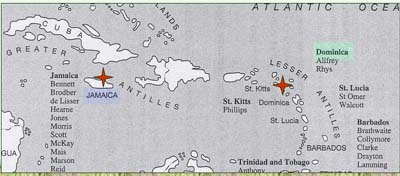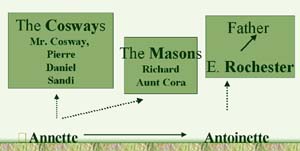|
|
||||||||
|
|
||||||||
Jean Rhys (mainly from the World
of Penguin)
(from fiction rag) Her style "Rhys
often wrote about women-- in various stages of their lives -- living
hand to mouth in London or Paris. The women are always on the economic
edge, needing money, receiving cash and clothes from men, drinking,
sitting in cafes, and endlessly walking. The books are very
spare, stark, unsentimental, and wonderful."
|
I. |
I. Shift of dates: In Jane Eyre -- Bertha confined in the attic in the first decade of the 19th century. WSS's time frame shifted to 1830's onwardsII. "More than one Antoinette" Annette and Antoinette as victims of Emancipation and the gender/racial relationships then.
|
|
Jean Rhys's late, literary masterpiece Wide Sargasso Sea was inspired by Charlotte Bronte's Jane Eyre, and is set in the lush, beguiling landscape of Jamaica in the 1830s. Born into an oppressive, colonialist society, Creole heiress Antoinette Cosway meets a young Englishman who is drawn to her innocent sensuality and beauty. After their marriage the rumours begin, poisoning her husband against her. Caught between his demands and her own precarious sense of belonging, Antoinette is driven towards madness. Settings: Part I: (Martinique), Jamaica: Coulibri estate, near Spanish Town Part II: Granbois, Dominica, Part III: "Great House" England;  Characers:
Christophine, Tia, Amelie, (minor ones: Baptiste)
 |
Racial relationship: Tia and Antoinette |
Parts II and III
-- her limited understanding of the world -- -- p. 42 "Oh England, England",” -- p. 47 her Paris; "Is it true,' she said, `that England is like a dream?" -- his illness and discomfort: p. 40, 41, blanks in his mind 45; p. 55 insecure -- p. 39; p. 43 -- the priest's ruined house--Pere Lilievre--Pere Labat pp. 62-63; 83 -- p.67 her premonition--having to go to England to fulfill her dream -- p. 88 "You ruined the place for me" -- p. 89 "red-eyed, wild-haired" -- p. 96 Rochester's being blinded -- p. 111 "something I[A] must do." -- Agreed to everything 39; "not yet"; --not love her; perform and hide things p. 45, 61 --p. 55 watch her die many times -- response to Christophine's plea for love p. 99 Rochester's Marriage and Inheritance: p. 41; 69; his letter to the "Father" e.g. 38, 45, 97 -- e.g. the turning point in his conversation with C 95; -- confusing the causes of his misery 97 -- Turning Antoinette into Bertha pp. 68, 81, and then to Marionette -- his self-pity and possessiveness (my lunatic), p. 99; References to madness:
|